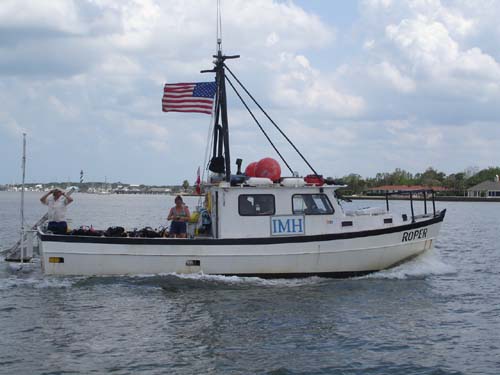
R/V Roper, the research vessel of the Institute of Maritime History, is on loan to LAMP through the end of July. A crew of five IMH divers delivered this working dive boat from Maryland to St. Augustine in late May.
We had anticipated the arrival of the R/V Roper for months now, and in late May the day finally arrived. We had heard from our colleagues in the Chesapeake region about this vessel, about what a fantastic working dive boat she is, and finally we were going to find out for ourselves.
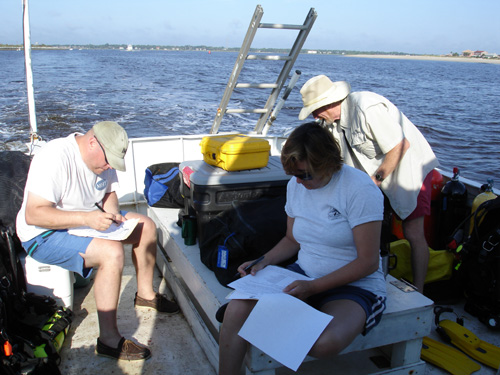
We had heard correctly–the Roper is nothing short of fabulous. Well, she may not be all that pretty to look at, but beauty is in the eye of the beholder, after all, and for a crew in need of a hardy, robust, well-laid-out and well-equipped working dive boat, the Roper is the belle of the ball. After the Roper‘s arrival, we went out for a day of diving on our field season shipwreck site, the Steamship and Ballast Pile wrecks. Joining us were the Roper‘s crew of five avocational archaeological divers, used to the cold, dark murky waters of the Chesapeake Bay or Potomac River. Before visiting divers enter the water, they have to fill out a lot of paperwork–an occupational hazard for scientific divers. Pictured here are IMH divers Kirk Pierce and Isabel Mack, and LAMP volunteer diver and medical officer Tank Brunswick.
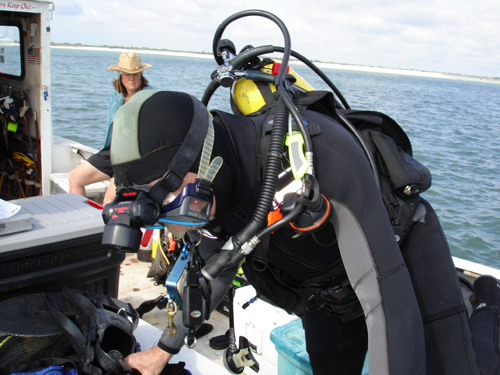
Under all this equipment is IMH diver Dan Lynberg. Like most of the IMH diving research team, Dan has the equipment, training, and experience to conduct zero visibility dives. That is a good thing considering the seven days straight of rain we just had the previous week–it has ushered in unprecedented amounts of mud to the water, reducing visibility to zero on the bottom and a significant portion of the water column. If these IMH divers were expecting warm, clear Florida waters, they were in for a surprise! At least it was warm (by their standards, at least, as it is still a little chilly for us Floridians). And as it turned out, they felt right at home in the black vis, declaring it worse or as bad as anything back home and clamoring for a second dive. In the background is IMH diver and Roper mate Dawn Cheshaek.
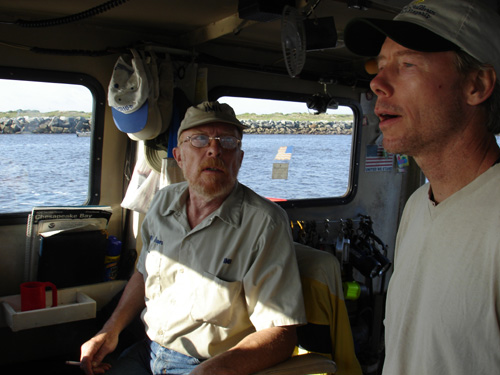
On the left is Dave Howe, owner and operator of the Roper and IMH’s most active Board member. He is talking shop with Dr. Sam Turner, LAMP Director of Archaeology who also happens to be IMH’s President. IMH is based in Kensington, Maryland, and they work mostly in the Chesapeake region. But for the next few days they will be working with LAMP offshore America’s Oldest Port.
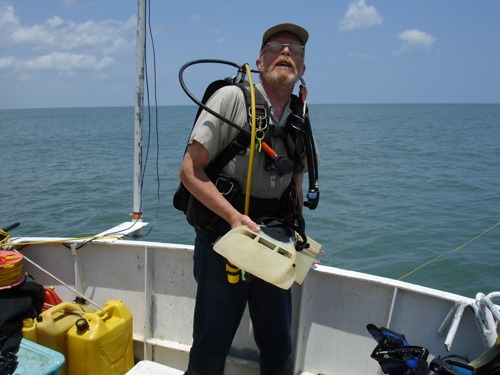
Dave Howe is a longstanding diver and avocational archaeologist. He is also an old-school diver. He is the only one of all the IMH and LAMP divers to completely eschew a wetsuit, preferring to dive in his jeans and shirt!
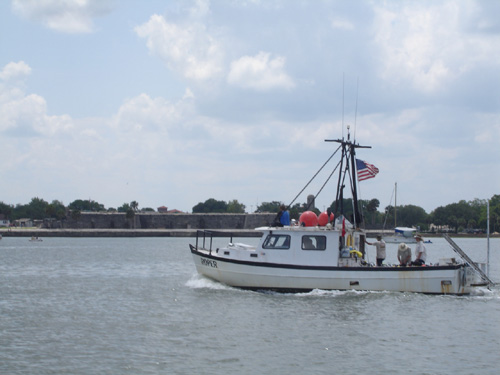
After the first day of diving with the IMH crew, we need to refuel Roper. So instead of turning back into Salt Run we continue in to Matanzas Harbor. Here the Roper passes the Castillo, the 17th-18th century Spanish fortification that has guarded St. Augustine and the inlet for centuries.
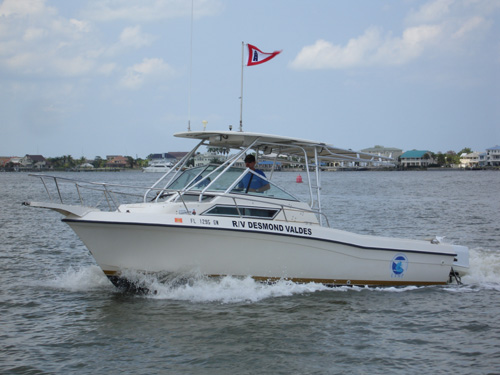
On the way, we are overtaken by LAMP Archaeologist and Logistical Coordinator Brendan Burke in the R/V Desmond Valdes, out on a sea trial after recent repairs. This fabulous offshore diving vessel, a 23′ Grady White, was recently donated to LAMP by the Desmond Valdes family and is named in his honor.
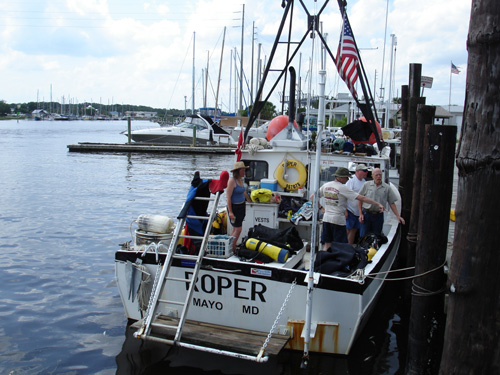
We bid Brendan farewell and head towards Daryl Poli’s Marine Supply and Oil on the San Sebastian River. This is the traditional working waterfront of St. Augustine, where hundreds of shrimp boats were docked, serviced, built, and worked. Roper started her life as as shrimpboat, built in North Carolina in 1991.
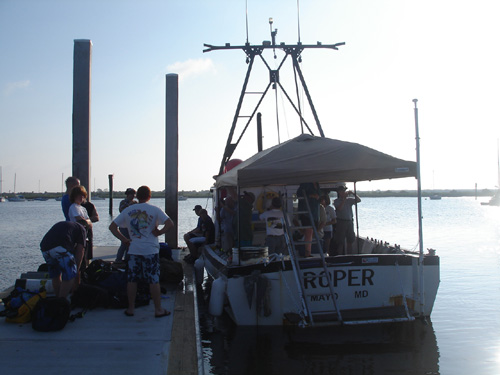
On the following day, a Saturday, we welcome to the Roper students from the Pedro Menendez High School MARC diving and archaeology class. These students need their final checkout dive in order to be certified. All are strong students who have been through many weeks of scuba training. The visibility on the bottom consists of a sizable layer of liquid mud, slowly settling and consolidating on the bottom as time goes by without more rain. It is a good thing that our new divers are well-trained, and we safely lead each student on a tour of the wreck sites. They all thoroughly enjoy the dive, despite the low vis. It will be a dive to remember.

LAMP Director and NAUI instructor Chuck Meide leads four of the eight students on a dive to familiarize themselfves with the wrecks of a 19th century steamboat and an unknown sailing vessel–which might, just might, turn out to be the Jefferson Davis . . .
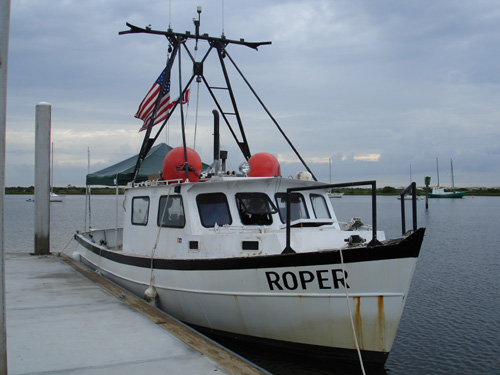
Unfortunately the stay of the Roper’s crew is far too short, and while we had Kirk for two extra days they have all headed home. While they were here our primary objective was to familiarize ourselves with this vessel since we will be using her extensively for the next two months. We finished checkout dives for our high school archaeology students, and spent a lot of time diving on our site preparing it for the upcoming excavation and field school students. We also conducted some remote sensing survey from the vessel, which is another of her primary functions back home. This is a lot of boat, and she will make a big difference in our field season, which is just getting started. Stay tuned for more updates from our fieldwork and field school, which at the time of this writing is underway and going strong!

